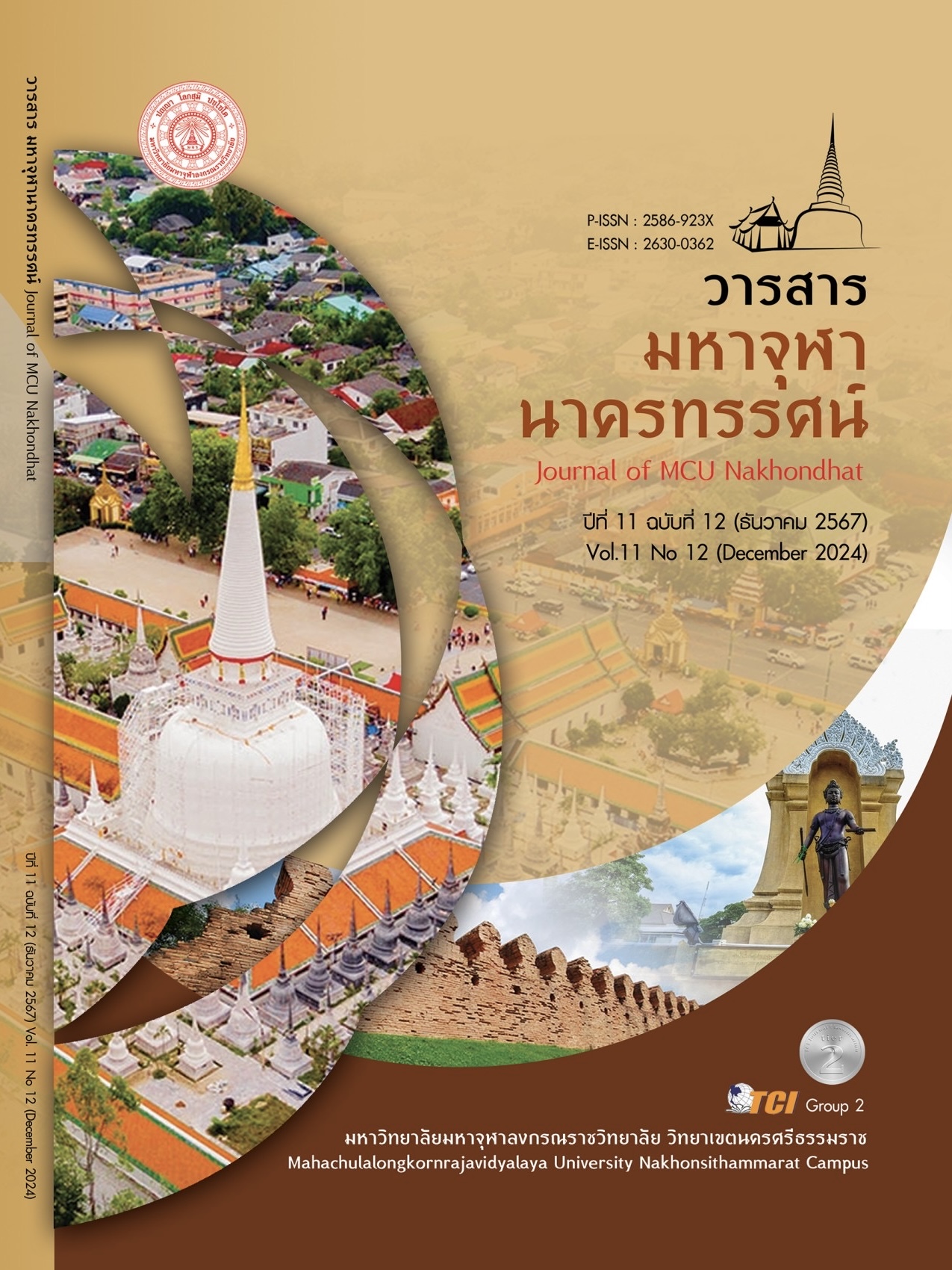THE DEVELOPMENT OF LEARNING PROCESSES USING ARTIFICIAL INTELLIGENCE SYSTEMS TO PROMOTE HIGH-LEVEL THINKING SKILLS AND INNOVATORS OF STUDENTS IN EDUCATIONAL OPPORTUNITY EXPANSION SCHOOLS EDUCATION AREA 1, NAKHON SI THAMMARAT PROVINCE
Main Article Content
Abstract
The objectives of this research were to 1) Study the context, background, and problems of the schools in the expansion of educational opportunity in Nakhon Si Thammarat Province, 2) Develop an AI learning process for the expansion of educational opportunity in Nakhon Si Thammarat Province, and 3) To assess the thinking competence of students in the expansion of educational opportunity in Nakhon Si Thammarat Province. The target group was 176 secondary 2 students studying technology (computer science) on problem-solving with the Scratch program. This research used an action research methodology that consisted of 4 steps of research: 1) Survey the school context using the expansion of educational opportunity school context survey form, 2) Organize activities in the school with an activity plan to develop an AI learning process for students in the expansion of educational opportunity and have students study the Scratch program manual to create a Chatbot, 3) Assess students’ thinking competence using the Thai Can High Competency Assessment, and 4) Summarize the results of the assessment of students’ thinking competence. The research results found that 1) The context, background, and problems of expanding educational opportunities schools mostly lack teaching media and insufficient computers for the number of students. Including the lack of a comprehensive internet system 2) The process of developing learning with an artificial intelligence system allows students to practice thinking processes and enjoy activities in the learning process. Students are determined and interested in the process of creating Chatbot AI with the Scratch program. 3) The evaluation results of Thai students' high thinking competencies found that 58.2 percent lack confidence in their thinking competencies. Therefore, schools or educational institutions should focus on students' thinking competencies so that students can think and develop their innovators in the future.
Article Details

This work is licensed under a Creative Commons Attribution-NonCommercial-NoDerivatives 4.0 International License.
References
กมลชนก พูลสวัสดิ์ และคณะ. (2565). ปัญญาประดิษฐ์กับการจัดการเรียนการสอนวิทยาศาสตร์. วารสารครุศาสตร์อุตสาหกรรม, 21(1), C1-C8.
กระทรวงศึกษาธิการ. (2560). แผนการศึกษาแห่งชาติ พ.ศ. 2560 - 2579 สำนักงานเลขาธิการสภาการศึกษา. (พิมพ์ครั้งที่ 1). กรุงเทพมหานคร: บริษัท ปริกวัน กราฟฟิก จำกัด.
คณะกรรมการอิสระเพื่อการปฏิรูปการศึกษา. (2562). รายงานพันธกิจการปฏิรูปการศึกษาไทย. เรียกใช้เมื่อ 20 กันยายน 2567 จาก http://backoffice.onec.go.th/uploads/Book/1734-file.pdf
ฉันทนา ภุมมา และคณะ. (2564). สภาพปัจจุบันและปัญหาชุมชนการเรียนรู้ทางวิชาชีพของโรงเรียนขยายโอกาสทางการศึกษายโอกาสทางการศึกษายโอกาสทางการศึกษายโอกาสทางการศึกษา สังกัดสำนักงานเขตพื้นที่การศึกษาประถมศึกษา. วารสารครุศาสตร์ปริทรรศน์, 8(3), 247-255.
ทัศนีย์ บุญแรง. (2560). การพัฒนาการจัดการเรียนรู้ของครูเพื่อส่งเสริมทักษะการคิดโดยใช้ของเล่นพื้นบ้าน. วารสารวิชาการมหาวิทยาลัยฟาร์อีสเทอร์น, 11(3), 105-117.
นฤภัค สันปาแก้ว. (2566). แนวทางการส่งเสริมครูในการจัดการเรียนรู้ในยุค AI. วารสารวิจัยนวัตกรรมการศึกษาและเทคโนโลยี, 1(2), 44-50.
ปิยะนันท์ หิรัณย์ชโลทร และสิทธิกร สุมาลี. (2561). การพัฒนานวัตกรรมการจัดการเรียนรู้เพื่อพัฒนาทักษะการคิดของผู้เรียนในระดับประถมศึกษา. วารสารศิลปากรศึกษาศาสตร์วิจัย, 10(1), 44-60.
พีรกฤต เครือลุนทีระยุทธ. (2567). การสร้างสรรค์นวัตกรรมสามัญประจำตัวครูเพื่อพัฒนาครูผู้สอนระดับการศึกษาขั้นพื้นฐานด้านนวัตกรรมการเรียนรู้จากอำนาจละมุน:การนิเทศแบบชี้แนะโดยใช้ชุดฝึกอบรมด้วยตนเอง. วารสารนวัตกรรมการศึกษาและการวิจัย, 8(3),1149 -1165.
วัชรี กิตติวิโรจน์ชัย และคมศิลป์ ประสงค์สุข. (2567). การบริหารจัดการเทคโนโลยีสารสนเทศของสถานศึกษาในยุคดิจิทัลของโรงเรียนขยายโอกาสทางการศึกษายโอกาสทางการศึกษายโอกาสทางการศึกษายโอกาสในศูนย์เครือข่ายพัฒนาคุณภาพการศึกษาสบป่อง - ถ้ำลอด สังกัดสำนักงานเขตพื้นที่การประถมศึกษาแม่ฮ่องสอน เขต 1. วารสารการบริหารการศึกษาและภาวะผู้นำ มหาวิทยาลัยราชภัฏสกลนคร, 12(47), 68-77.
ศักดิ์ชัย ไชยรักษ์ และปณิตา วรรณพิรุณ. (2563). เทคโนโลยีทางปัญญาเพื่อการศึกษาอัจฉริยะ. วารสาร ปัญญาภิวัฒน์, 12(3), 315-328.
สำนักงานคณะกรรมการการศึกษาขั้นพื้นฐาน. (2562). รายงานผลการดำเนินงานประจำปี พ.ศ. 2562. เรียกใช้เมื่อ 20 พฤศจิกายน 2567 จาก https://www.obec.go.th/archives/290290
สำนักงานพัฒนาธุรกรรมทางอิเล็กทรอนิกส์. (2567). ETDA ร่วมกับ สวทช.เปิดผลการศึกษาความพร้อมในการประยุกต์ใช้ AI. เรียกใช้เมื่อ 18 พฤศจิกายน 2567 จาก https://www.etda.or.th/th/pr-news/AI_SurveyxETDA.aspx
สำนักงานพัฒนาวิทยาศาสตร์และเทคโนโลยีแห่งชาติ. (2566). แผนปฏิบัติการด้านปัญญาประดิษฐ์แห่งชาติเพื่อการพัฒนาประเทศไทย (พ.ศ. 2565 - 2570). เรียกใช้เมื่อ 20 พฤศจิกายน 2567 จาก https://ai.in.th/wp-content/uploads/2023/08/AI-Thailand-Annual-2023-1.pdf.
สิโรดม มณีแฮด และปณิตา วรรณพิรุน. (2562). ระบบนิเวศการเรียนรู้ดิจิทัลด้วยปัญญาประดิษฐ์สำหรับการเรียนรู้อย่างชาญฉลาด. วารสารศึกษาศาสตร์ มหาวิทยาลัยนเรศวร, 21(2), 359-373.


